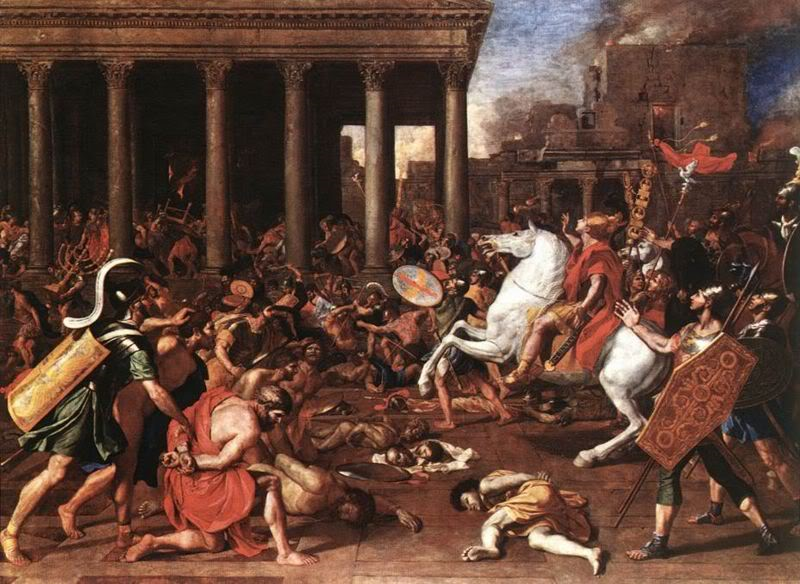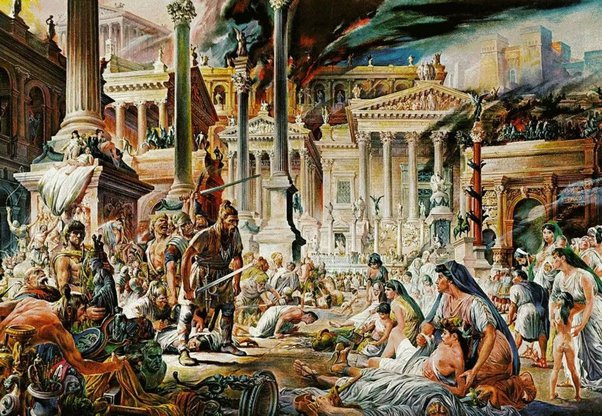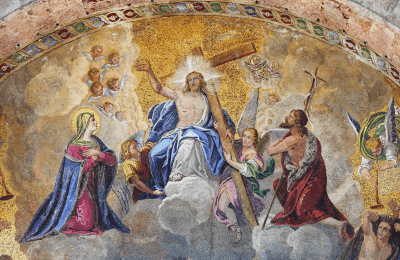The fall of Rome is not an image of a glorious and mighty empire at its peak falling to hordes of Barbarians. Instead, like the decline of other civilizations, it was a long and drawn-out process with many starts and stops along the way. As a result, the fall of Rome does not have an exact date. A key date, however, was 476 AD, when Germanic leader Odoacer deposed the last emperor of Western Rome, a so-called barbarian general. This is an excellent place to end the story since there would never again be a Roman Emperor in Rome.
However, that was not the end of the empire. Well before the city of Rome was conquered, the Empire had split into two. For years, the empire had been wracked by civil wars, rebellions, and all sorts of strife. The reasons behind this collapse are primary subjects of study by historians of the ancient world, some of which are listed below.
Barbarian invasions

One of the most straightforward theories behind the fall of Rome is external factors such as barbarian invasions. It suffered a series of military losses starting from the battles against Germanic tribes for centuries. By the 300s, it had to fight with barbarian groups such as the Goths, who intruded its borders.
In AD 406, the Roman legions evacuated Britannia, and the Anglo-Saxons moved into the place. The Huns pushed some of their groups into the west and eventually into Roman territory. This led to King Alaric and the Visigoths sacking Rome while Vandals invaded Spain and North Africa, again dismissing Rome in AD 455.
Lastly, in 476, Odoacer started a revolt and overthrew Emperor Romulus Augustulus. After that, no other Roman emperor ruled in Italy, making the year 476 the year of the death of the Western Empire.
Economic crisis

Major financial crisis contributed to Rome’s fall, among notable internal factors. They went through a severe economic meltdown due to the constant wars and overspending. Inflation and oppressive taxation had broadened the gap between the rich and poor. Many upper-class members would escape to the rural areas and form independent domains to avoid paying taxes.
The empire also lacked laborers, which greatly affected Rome because it depended on enslaved people to till lands and work as craftsmen. As a result, the military had to force conquered peoples to work. This worsened in the second century, and by the fifth century, a further blow came as the Vandals conquered North Africa and disrupted economies in the Mediterranean. As a result, the empire slowly began to lose grip on Europe as its economy faltered, mainly due to decreased agricultural and commercial production.
The birth of the Eastern Empire

Emperor Diocletian divided the Roman empire into two-the Eastern and Western. The Western covered the city of Milan while the Eastern seated in Byzantium, which would later become Constantinople. This division was beneficial at first because the empire became easier to govern, but the two drifted apart over time.
They could not work adequately together to fight external threats and would even compete over resources and military support. As a result, the gulf widened, and the Greek-speaking Eastern Empire grew wealthier while the Latin-speaking West sank into a financial crisis. The East drew Barbarian invasions to the West as emperors could tightly guard and fortify the city of Constantinople. The Western political system came apart by the fifth century, while Eastern Europe endured for thousands of years more until the invasion of the Ottoman Empire in the 1400s.
Overexpansion that led to military overspending

The Roman Empire was preoccupied with expanding. It extended from the Atlantic Ocean to the Euphrates River at its peak. This grandeur may have also been its downfall because it had to govern such a vast territory. As a result, the empire faced logistical and administrative challenges. Even if they built sophisticated roads, the Romans struggled with communicating quickly and effectively to manage their dominion.
In addition, the empire had problems managing troops and resources to defend its territory from local and outside attacks. By the second century, Emperor Hadrian built his wall in Britain just to keep the enemy away. More funds were put into the military efforts, thereby slowing technological endeavors that resulted in the decline of civil infrastructure.
Corruption and political instability

Rome’s expansion and size made it challenging to govern, and the inconsistent and ineffective leadership worsened the problem. The Roman emperors had a very delicate job, especially during the second and third centuries when it even became deadly. The Civil War pushed the empire into a more chaotic land. Within 75 years, more than 20 people took the throne because of the murder of a predecessor.
The personal bodyguards of the emperors would assassinate and establish a new ruler at their desire and would even auction the position to the highest bidder. The problem reached the Senate, which failed to control the abuses of the emperors because of incompetence and corruption. As the problem worsened, many citizens lost confidence in the leadership, and civic pride weakened.
The Huns’ invasion and barbarian migration

The Huns were a group of Eurasian nomads who migrated to Europe in the late fourth century. They drove the Germanic tribes to the borders as they stormed through Northern Europe. The Romans brutalized the Goths when they allowed them to pass the Roman territory. Officials forced the starving people to enslave their children in exchange for dog meat. They created a dangerous enemy into their borders because the Goths rose up in revolt when they could no longer bear the Romans’ oppression.
In AD 378, during the Battle of Adrianople, the Goths killed Emperor Valens of the east. This revolt shocked the Romans, so they tried to negotiate peace with the barbaric group, but the agreement unfolded in 410 when King Alaric moved west and dismissed Rome. As the Western Empire declined, the Saxons and the Vandals spread across its borders and occupied Spain, Britain and North Africa.
Growth of Christianity

The fall of Rome coincided with the expansion of Christianity, and some historians believe that the growth of a new faith contributed to the decline of the empire. An agreement called the Edict of Milan in 313 AD between Western Emperor Constantine I and Emperor Licinius of the Balkans asserted that Christians should now be treated benevolently within the empire. In 380, Christianity became the state religion.
These events freed the Christians from years of persecution. However, some scholars say it may have also worn traditional Roman values. The Romans believed in a polytheistic religion, with the emperors benefitting from a divine status. Christianity slowly displaced this belief and focused on a sole deity, away from the state. To make things worse, popes and other church key persons participated in political affairs that further complicated governance.
Decline of the Roman legions

Rome was renowned for its powerful military. It was the envy of the ancient world. What used to be mighty legions began to weaken. The military found it hard to recruit ample Roman soldiers. Emperors Constantine and Diocletian hired foreign soldiers to meet their needs. So the legions included Germanic peoples and other barbarians that the Romans even called their soldiers barbarous, a Latin word.
The Germanic soldiers were fierce warriors but not loyal to the empire. Their officers would often turn against the Romans. The same barbarians who sacked Rome and the Western empire served the legions while they earned their military stripes.
Climate change

Some agree that environmental factors also play a role in the decline of Rome. However, scientists draw evidence from natural sciences and assert that these are deeper causes even if human factors are integral. To them, forces of nature are more powerful, and other factors are just surface effects. The story of Rome’s decline teaches us that human societies are fragile, and we are highly dependent on this fickle planet.
Researchers said that the Romans were even lucky to have flourished during the period of climate optimum, stating that the climate from 200 BC to AD 150 was stable across the Roman territory. This boosted agriculture, and there was enough food for the people. The times changed during the middle of the second century, and the climate became less reliable. The Nile River became erratic while cold spells and droughts became more common. This shows how societies can be so sensitive to the changes in nature.
Diseases

In AD 160, the Romans experienced the first recorded pandemic called the “Antonine Plague.” The outbreak resulted in 7 to 8 million casualties. While the cause remains debated, evidence turns out that smallpox in Africa was the likely candidate. The Romans traded a lot then and reached the East African coast. Such trade brought new products such as precious metals and spices; little did they know, they also carried germs.
The pandemic led to an unsettled social order, and maintaining the empire’s dominance became more challenging. After the plague, a severe drought struck and another pandemic, the Plague of Cyprian, broke out. The Huns moved to the West from Central Asia due to droughts and terrified the developed kingdoms, and Western Rome was reformed as a Germanic kingdom.